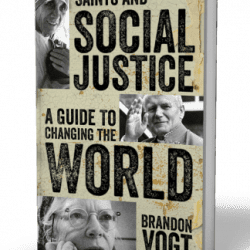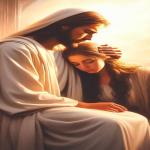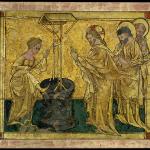 Avril Pyman, Pavel Florensky: A Quiet Genius (New York: Continuum, 2010); 304 + xxii pgs.
Avril Pyman, Pavel Florensky: A Quiet Genius (New York: Continuum, 2010); 304 + xxii pgs.
Pavel Florensky (1882 – 1937) is the kind of theologian that the world desperately needs today. He was able to embrace a wide range of methodologies in his search for truth. He understood the results of such searches, as they are to be done by different means, will lead to different conclusions. A philosophical exploration will reveal something different than an empirical scientific exploration, but both will lead to discoveries about truth. But when that happens, he believed they might not be able to be synthesized into one over-arching system. They reveal, instead, complementary aspects about the truth, but to grasp the wholeness of truth is beyond the human mind. Any attempt will be a construction of the human mind which loses out in its attempt. Different encounters with truth will reveal truth, but, the human person must be willing to let them be, to accept the gaps which cannot be breached between these different revelations. Truth can appear to contradict truth. If one comes about with two necessary truths which do not seem to work together, one has come across the paradox of antinomy. And for him, such paradox cannot be transcended — it can only be acknowledged. This is not to say all contradictions are acceptable, nor that there is not a way in which such truths can and do work together. For him it is the way we try to explain and reveal how they work together which is the problem. Mathematics paved the way for him to explain what he means: discontinuous functions show that these gaps, these voids, can exist, that they need not be feared, but embraced. In this way, one can see Florensky anticipated much of what was to come about in post-modernism, but he did it in the early decades of the twentieth century.
Not many in the West have heard the name of Pavel Florensky, and yet he was perhaps one of the greatest thinkers and geniuses of the twentieth century. Often compared to Leonardo da Vinci, Florensky was a polymath — a scientist, a mathematician, a teacher of the arts, a philosopher, a theologian, a priest, and a family man. While a few of his important works are now available in English, it might be better to first to get to know the man; this biography by Avril Pyman allows one to do so and in doing so, get a fine introduction to Florensky and should allow people to understand why he is so important a figure in world history.
Much of Florensky’s life is difficult to understand and appreciate without understanding the Silver Age of Russian thought. Pyman does a good job in trying to help the uninitiated into this world — both in the biography, and in the glossary at the back of the book, but I expect, for some, this will not be enough to appreciate Florensky’s contributions, not only to Russia, but to the field of theology. This is still, with all the aid, not an easy book to read, because Florensky is not an easy man to analyze. Pyman tries to make Florensky as accessible to the reader as possible, and I think does a good job at it. One gets a great sense of the man through what she quotes from him, especially from his correspondences to his family and friends. But it is clear, without reading his major works afterward, one will be at a loss to appreciate how great he actually is. One needs both a biography and a reading of his works to understand exactly who he is.
This difficulty does not mean people who do not want to read his books should ignore this one; rather, I hope by reading this, they have such a good introduction on Florensky they might be interested in reading those works of his now available in translation. Pyman takes great pains to explore them, to situation them in their context in his life, especially The Pillar and Ground of Truth. One can appreciate how this early theological work, which is also arguably his greatest work, was written in part to come to terms with his own conversion to Orthodoxy. And in it, one gets the sense of how love is central to this, how love is for Florensky the bridge which is capable of uniting what the mind cannot, of how love, combined with intellectual thought, is capable of bringing one outside of doubt and into a life of faith. Anticipating the turn which was to take place into theology in the twentieth century, Florensky’s works transcends most other theologians because of his unique mind with the wide-ranging diversity of subjects he mastered.
One can tell Pyman is sympathetic to her subject by the way she engages the two major controversies surrounding him (the possibility of latent homosexuality and latent anti-Semitism). She deals with the questions, but doesn’t seem to seek controversy with them, but rather, to lay out the facts and deal with them as she understands them.
As to the possibility of some sort of homosexual tendencies, the likelihood is great. Pyman provides us evidence in its favor in a few places in her book. He was, even in his youth, an aesthete, which made him appear to many, including his family, as being very effeminate. But it was the close bonds he developed with various friends, bonds which appeared to be romantic in nature, which caused many, including his friends to question his orientation. Pyman offers us an entry from the diary of one of Florensky’s friends, El’chaninov, from 1909, where it is clear that his friends, as with Florensky himself, discussed Florensky’s tendency to form strong friendships with men, and to be mostly indifferent around women. In it, Florensky is said to have contemplated the situation and to give the following answer:
…then P stumbled upon the following hypothesis. A man seeks an object sufficiently passive to receive his energy. For the majority of men, such objects are women. There are insufficiently masculine natures who seek their complement in masculine men, but there are also hyper-masculine men, for whom the feminine is too yielding, as yielding as a cushion, for instance, to a steel blade. That kind seeks and loves simply men, or insufficiently masculine men. (71).
If there is ever a quote which could indicate some latent homosexuality within Florensky, it is this one. Florensky is clearly acknowledging his own liking for men over women. And yet it must be read within a greater context, one which might mitigate some, but not all, of the aspects of this quote. Florensky was an aesthete who had found a love for classical civilization and thought, especially as found in the works of Plato. Platonic love was an ideal for him; and for a long time, long before Florensky, such love was known to create strong bonds and relationships between men, bonds which many of them felt transcended the erotic. What Florensky could be describing is his attempt to understand why he was interested in this other form of love, what it was that made some men attracted to all-male friendships to the exclusion of women. But it is also clear, though mostly indifferent to women, they were not entirely outside of Florensky’s view, and Pyman does relate that there were times he showed interest in being with them even before his marriage.
Nonetheless, Florensky wasn’t interested in marriage and, in his early years as an Orthodox convert, he wanted to become a monk and a part of a monastic brotherhood. Indeed, he looked at the way monks could be bound together with a special prayer as indicative of the bonds of loving friendship he thought two men can and should possess. It is perhaps because of a latent homosexuality that this was an attraction to him, and why his spiritual adviser and friend, Bishop Antonii, forbade him from becoming a monk and told him he had to marry. When Florensky did, not only did it allow him to become a priest, but it is also clear, from the description had about his relationship with his wife, and later his children, it was for his own good.
As to the charge of anti-Semitism, Pyman ultimately rejects it. But she does so without whitewashing Florensky and his relationship with the Jews, allowing the reader to understand why others might see an element of it in Florensky. Thus, she suggests that Florensky held some distrust of the Jews, possibly as the result of his own family upbringing. She also points out that, in his youth, he once insulted some Jewish neighbors of his by using a denigrating term: Yid. He was a young kid, and had just heard the term himself, and used it like young kids do after hearing it. But, as she points out, in his reminiscences which he wrote for his children, he understood his act as a transgression.
It is in some of his later writings in which find anti-Semitism, especially in connection with his friendship and work with Rozanov. There were false claims of Jews sacrificing children, and in the midst of it, Florensky defended the notion that Jews did have, in their history, blood sacrifices and that what was in the Torah was not mere legend. He was not trying to make the claim that present day lies against the Jews were true. But many others used the Torah’s use of blood sacrifices to indicate it was connected to the Jewish nature to be “bloody” and justify abuse against the Jews. And it is for this reason some have read, in his connection with Rozanov, a discernable anti-Semitic viewpoint. But Pyman wants to reject this as being too simplistic. The point she tries to make is that one needs to read his discussions within his own theological debates, and his interest were different from the social antagonism around him. He didn’t look on the blood sacrifices as a negative thing. She points out how he himself said he would have done them if he had been born a Jewish priest in the ancient world. But more importantly, she shows how Florensky viewed the debate as a spiritual debate, between Christianity and Judaism and whose spirituality would come into play in the immediate future. He was not aiming for any hostility to the Jews, as she shows from a quote of his from introduction to a collection of articles entitled, Israel in the Past, Present and Future:
It is not the political and not the socio-economic aspect of Judaism taken as such but the spiritual sense of the Divine Destinies which are in the process of working themselves out that is the object of this book. We [the people whose articles are in the collection] here are not suggesting any programmes, but are anxious only to clarify the spiritual relationship of the forces now locked in struggle in world history. (106)
While there is significant anti-Jewish sentiment in the collection, not all of it was of that view; after all, one of the essays was from Vladimir Solov’ev, who was himself an ardent defender of the Jews and viewed the situation as the problem of abuse created by Christians. Pyman in the end concludes that Florensky, fueled by the times, did find the Jews peculiar, but he did not blame them for the revolution as others from the Old Regime did, and that he was no “Russian nationalist.” Though he has friends who were anti-Semitic, she believes the evidence is against Florensky’s own anti-Semitism: “Yet nowhere in Florensky’s family letters or elsewhere in his life or his written work, as far as I have seen them, are there traces of anti-Semitism” (106).
The information which has been recently released about the end of his life, and when exactly he was killed, has been put together in as good a presentation as is currently possible. They are interesting and important, not only because they relate to his own martyrdom, but also because what happened to him is so reminiscent of much which has been happening in and around the so-called War on Terror.
After the 1917 revolution, Florensky, though a priest, was able to have a position in Soviet society because of his technical expertise; he found himself having to support himself with it, not only by teaching, but writing and editing technical articles for publication. His contribution was tremendous: for example, for the Technical Encyclopedia he wrote from 127 to 134 entries, and worked as co-editor for vols. 1-12 and 26. He also wrote and published many other technical works in this time, such as the book, Carbolite: Its production and properties. He was in 1928 charged and convicted of being a part of a counter-revolutionary plot (which he had no part of), and released from prison in 1929, in part because of his close association with high ranking officials due to his scientific work. But he was once again charged and arrested in 1933. In this second arrest, it is clear he was tortured, and through that torture, wrote and signed a confession indicating he was involved in some massive ecclesial conspiracy working with the Germans to bring Roman Catholic aid into Russia. The claim was that there would be a counter-revolution in Russia after the Orthodox and Catholic could work out a reunion between their respective communities. It appears what he wrote, under brutal conditions, has survived and it seems to mix elements of his own true thought with what he thought the interrogators wanted to hear. Of course, it did condemn him, and he was sent into hard labor, but it is also clear, the Soviets appeared to understand it was, in part, a fiction but a fiction which was forced to be created and condemned as a precaution to what kind of harm they saw Florensky might cause them in the future — he was preemptively taken out, tortured, and forced to create a false confession for the sake of the Soviet system. As Pyman relates:
Florensky, it seems from these incriminatory scraps, had little or no hope of liberation, either by amnesty or by serving out his time, because his interrogator told him, after an exhausting session in which he had refused to incriminate any of the various people suggested as his accomplices, that, as a matter of fact, they were well aware that he was not — as yet– guilty of any crime against the State, but that the function of Soviet security organs was to foresee possible threats and to act prophylactically. He was just the sort of person who might be used as a figurehead by reactionary forces or foreign powers and must therefore be neutralised before this could happen(158).
Here we see what happens under a tyrannical system which rules under fear; it must not just fear real criminals and real acts against the state, but any ones which might have the possibility of becoming such a threat, even when it is not. This is exactly the mentality which got the United States at war with Iraq, and it seems to be the kind of mentality behind its use of torture to break down people who they capture as possible terrorists (many who the United States knows are not actual terrorists, but ones it fears could become such, if not prevented from doing so). In this way, the events surrounding Florensky in the Gulags are important to us today as a society, to show us the direction our society is going, to bring into concrete form why such a strategy is fundamentally flawed.
After his confession, the rest of Florensky’s life involved being moved around from prison camp to prison camp, his expertise still being used by the Soviets in forced labor, and then, in 1937, when the prison population was too big to be sustained, he with many of his co-laborers were shot and put into communal graves. While he suffered greatly in this time, he still continued his scientific interest, doing studies not only on permafrost, but also, in the production of iodine and agar. He was, from the letters he was allowed to write to his family, in the early camps given more luxury because of what he was doing for the Soviets, but found that luxury was slowly lost to him as he was moved about from camp to camp. During this time, he also head, much to his horror, how his family’s place was ransacked, and he feared all his work which he had done through the years would be lost to posterity — that the humanity he tried to help improve will lose all that he gave them by such acts of inhumanity. He suffered greatly, and yet… kept his faith, and indeed, it appears people around him might have even come to the faith through him. While his death was done when there was a need to get rid of a great number of prisoners, it was because of why he was put into the Gulags that one must read the end of his life as one of a confessor turned martyr. His death was for his glorification, but at what expense it was for the world, perhaps we will never know in this life.
Avril Pyman’s book is highly recommended for anyone interested in Florensky. While the biography itself is relatively short (less than two hundred pages), it is supplemented by a significant timeline based upon his life, and a the aforementioned glossary of names which will help the average reader unfamiliar with the Silver Age of Russian thought. It is not, as Pyman points out, a comprehensive biography — much of the material which would be needed for that is still being released, but it does provide a needful introduction to a man who could just as well have had the greatest mind in the twentieth century. It shows the complexities of his life, and shows that he was a man, with his own foibles, and they too must be understood in order to understand his writings as a whole.
4/5 stars.















